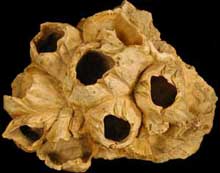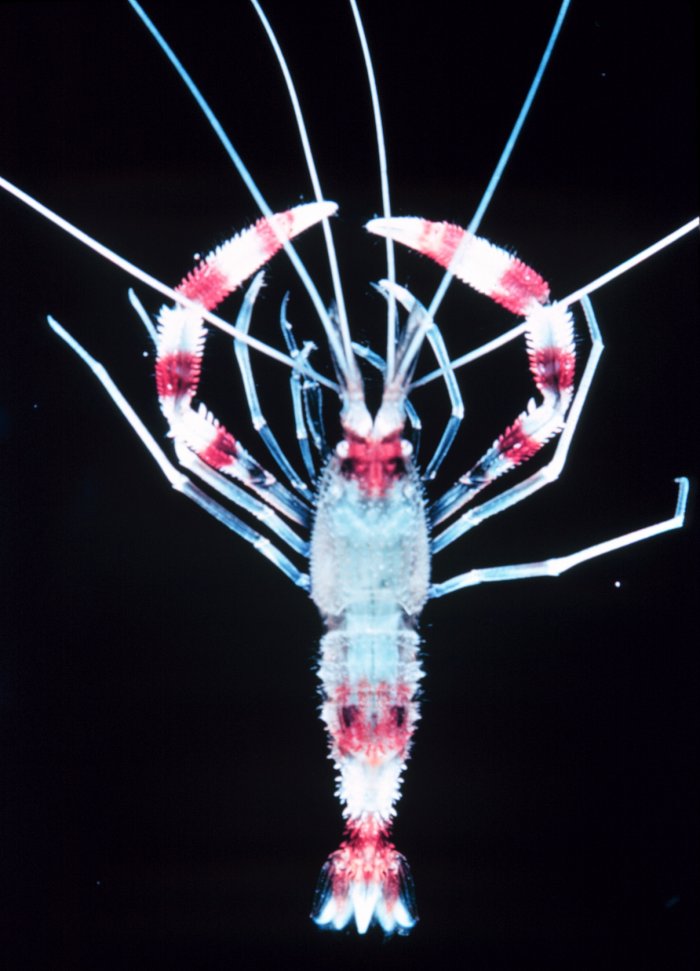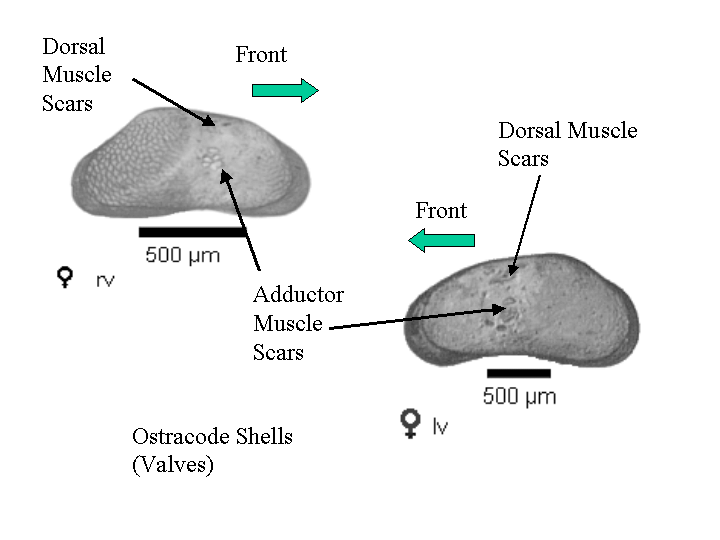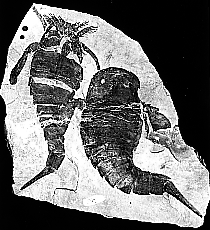
Fossil Barnacles, image shown
with
permission from
the University of California
Museum
of Paleontology
Invertebrate Paleontology Lab #10
Phylum Arthropoda Part II: Crustaceans
and Other Arthropods
Click on the lab title to see the University of
California
Museum of Paleontology web page
Read BEFORE Coming to Lab: Benton & Harper p. 375--388
Introduction
The Arthropod Phylum includes four
Subphyla:
the Chelicerates (including arachnids, eurypterids, and horseshoe
crabs),
the Crustaceans (lobsters, crabs, shrimp, barnacles, ostracodes, and
others),
the Tracheata (the insects, centipedes, and millipedes), and finally,
the
famous fossil group, the Trilobitomorpha (Trilobites)
(Cambrian-Permian).
This week we will continue our exploration of the Arthropods with an
examination
of the Crustaceans and Chelicerates, and a cursory look at the
Tracheata.
Basic shared characteristics of arthropods are listed in Table 1 below.
Table 1: Shared characteristics of Arthropods
Basic Facts to Know about
Arthropods: They are |
|
| 1. |
Eukaryotes |
| 2. |
Metazoans with organs, true tissues, nervous, muscular,
and reproductive
systems |
| 3. |
characterized by body segmentation (externally in
the exoskeleton,
and internally in the nervous, muscular, hemal and excretory
systems). |
| 4. |
characterized by Bilateral Symmetry, with a distinct
anterior (acron)
and posterior (telson). As in annelids, the most recent segment
is
directly anterior to the telson. |
| 5. |
characterized by a rigid Exoskeleton (Cuticle)
composed of protein
and chitin (a polysaccharide), which must be molted
(shed)
in order for the animal to increase in size and add additional segments
and/or appendages. The Exoskeleton is strengthened (hardened)
through sclerotization
(all arthropods) and in addition, mineralization (crustaceans,
millipedes,
and trilobites). |
| 6. |
paired, jointed segmental appendages, typically these
appendages
are specialized for particular tasks |
| 7. |
found in all known oxygenated environments, aquatic
and terrestrial,
and in some hypoxic (very low oxygen) environments |
| 8. |
Excellent index fossils: widely distributed,
well preserved,
easily identified, rapidly evolving |
| 9. |
found to filter feed, or to be heribivores, predators,
scavengers,
detritivores, or parasites. |
| 10. |
gonochoric (males and females present, with a few
exceptions) |
The Crustaceans
appear in the early Cambrian fossil record in the fossils of
the
Chengjiang
Biota and in the mid Cambrian Burgess
Shale fauna. Of the many Classes of Crustaceans, the most
well
known groups in the fossil record include the Class Malacostraca
(crabs, shrimps, lobsters, krill, pill bugs, amphipods) and the Class
Maxillopoda (ostracodes, copepods, barnacles, plus others). A
feature of the Crustaceans is the adaptation of body segmentation and
appendage
specialization to every conceivable aquatic environment (besides
inhabiting
all nonmarine aquatic environments, crustaceans hold the record for
living
in the highest water temperatures known for metazoans, and also inhabit
deep aquifers and the cold abyssal depths of the ocean). As with all
arthropods,
crustaceans must molt their shells (a process known as as ecdysis)
in order to grow. The molted pieces are often fossilized and
occur
as common fossils in the marine sediment record and in the records from
lacustrine basins. Body segmentation varies within the
Crustacean
group. In many cases, you should be able to identify the head,
thorax
and abdomen of the organism, as in the lobsters and shrimp,
whereas
in other groups you will notice reduction in body segmentation, as in
the
case of the Brachyura (true crabs), where the abdomen is reduced to
just
a few segments visible on the underside of the carapace. Because
soft parts are not commonly fossilized, the shells are typically the
only
record we have of crustacean populations. This is particularly
the
case with barnacles and ostracodes (both of class Maxillopoda).
The Chelicerates
appear in Ordovician time (although marine arachnid fossils may
have been identified in Cambrian rocks). The chelicerate body is
divided into two sections, the prosoma (cephalothorax) fusing
the
head and thorax, and an opisthosoma (abdomen). There are
pairs
of appendages on all six segments of the prosoma, with the first pair
of
appendages modified with chelicerae (tiny claws) which are the
mouthparts.
The second pair of appendages are the pedipalps, which may be modified
to serve as mouthparts or for grasping prey, and then the remaining four
pairs are walking legs (hence the 8 legged spiders).
Part I: Draw 4 specimens of crustaceans or chelicerates in the
teaching
collection.
Is it a crustacean? If so, label the Class, and the Subclass or
Order
if available, and the time range. Label the head, thorax and
abdomen
if preserved. Label the appendages (walking, grasping?) In the
cases
of barnacles and ostracodes, draw and label the shells. Which way
is top (dorsal) which way is bottom (ventral?)
20 pts.
If you choose a chelicerate, label the prosoma and
opisthosoma,
and the Class, the Subclass or Order if available, and the time
range.
Images of Arthropods
Class Malacostraca, Order Decapoda, Devonian - Recent

Stenopus hispidus - banded cleaner shrimp. Image ID: reef0285,
The Coral Kingdom Collection, NOAA
Location: University of Hawaii Institute of Marine Biology
Credit: Photo Collection of Dr. James P. McVey, NOAA Sea Grant Program
Class Maxillopoda, Subclass Cirripedia (barnacles) Ordovician-Recent

image shown with permission from the University of California Museum
of Paleontology
Class Maxillopoda, Subclass Ostracoda (Ordovician - Recent)
The
ostracodes
are microcrustaceans that produce a hinged calcite shell, often
ornamented,
in which they can completely close themselves up. They live in
every
aquatic environment, from marine to freshwater to groundwater to
wetlands,
with the exception of very acidic water. They are slightly larger
than the forams (typically 500-700 microns), and can also be used as
both
paleoecological and geochemical data in paleoenvironmental and
paleoclimatic
reconstructions. The shell is commonly preserved, although often
disarticulated into two valves. When examining these bean shaped
valves, look for the adductor muscle scars. Other scars are
sometimes
visible, including the dorsal muscle scars. Ostracodes are
sensitive
to temperature and salinity in the deep ocean, and are used to map the
changing position of water masses through time. In fresh water
environments,
ostracodes are sensitive to water composition as well as
temperature.
Their rapid speciation, wide distribution, and commonly preserved
valves
make them excellent index species.
To see images of non-marine ostracodes in the NANODe (North American Non-Marine Ostracode
Database, click here.

Subphylum Chelicerata (Cambrian-Recent)
Subclass Eurypterida (Ordovician-Permian)

Image shown with permission from the University of California Museum
of Paleontology



